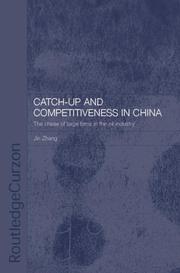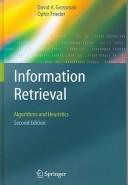| Listing 1 - 10 of 30 | << page >> |
Sort by
|

ISBN: 020344390X 1134317913 1280036672 0203412869 0415333210 0415653738 9780203412862 9781134317912 9780415333214 9781280036675 9781134317868 9781134317905 9780415653732 1134317905 Year: 2004 Publisher: London ; New York, N.Y. : RoutledgeCurzon,
Abstract | Keywords | Export | Availability | Bookmark
 Loading...
Loading...Choose an application
- Reference Manager
- EndNote
- RefWorks (Direct export to RefWorks)
This book examines the role of corporate structure, including the role of corporate headquarters, in the success of large firms. It considers these issues in relation to large global corporations, thereby providing a 'benchmark', which is then used as a contrast in a discussion of corporate structure and the role of corporate headquarters within large Chinese firms, many of which have evolved from former government ministries. It includes a detailed case-study of firms in the crucially important oil and petro-chemical sector. Overall, the book shows what a hugely competitive battle China's eme
Big business - China. --- Competition - China. --- Industries - Size - China. --- Petroleum industry and trade - China. --- Petroleum industry and trade. --- Petroleum industry and trade --- Industries --- Big business --- Competition --- Size --- S10/0523 --- S10/0260 --- S10/0580 --- -Industries --- -Big business --- -Competition --- Competition (Economics) --- Competitiveness (Economics) --- Economic competition --- Commerce --- Conglomerate corporations --- Covenants not to compete --- Industrial concentration --- Monopolies --- Open price system --- Supply and demand --- Trusts, Industrial --- Economic concentration --- Business --- Business enterprises --- Industrial production --- Industry --- Economics --- Energy industries --- Oil industries --- China: Economics, industry and commerce--Power supply (electricity, mining, oil) and computing industry --- China: Economics, industry and commerce--The Chinese model --- China: Economics, industry and commerce--Management of enterprises (general, theories) --- -Economic aspects --- Industries, Primitive

ISBN: 9783540751472 3540751475 3642094422 9786611134297 1281134295 3540751483 Year: 2008 Volume: 23 Publisher: Berlin : Springer,
Abstract | Keywords | Export | Availability | Bookmark
 Loading...
Loading...Choose an application
- Reference Manager
- EndNote
- RefWorks (Direct export to RefWorks)
The amount of digitized information available on the Internet, in digital libraries, and other forms of information systems grows at an exponential rate, while becoming more complex and more dynamic. As a consequence, information organization, information retrieval and the presentation of retrieval results have become more and more difficult. Information visualization offers a unique method to reveal hidden patterns and contextual information in a visual presentation and allows users to seek information in an intuitive way. Jin Zhang provides a systematic explanation of the latest advancements in information retrieval visualization from both theoretical and practical perspectives. He reviews the main approaches and techniques available in the field, explains theoretical relationships between information retrieval and information visualization, and presents major information retrieval visualization algorithms and models. He then takes a detailed look at the theory and applications of information retrieval visualization for Internet traffic analysis, and Internet information searching and browsing. The author also addresses challenges such as ambiguity, metaphorical applications, and system evaluation in information retrieval visualization environments. Finally, he compares these information retrieval visualization models from the perspectives of visual spaces, semantic frameworks, projection algorithms, ambiguity, and information retrieval, and discusses important issues of information retrieval visualization and research directions for future exploration. Readers of this book will gain an in-depth understanding of the current state of information retrieval visualization. They will be introduced to existing problems for researchers and professionals, along with technical and theoretical findings and advances made by leading researchers. The book also provides practical details for the implementation of an information retrieval visualization system.
Information visualization. --- Information retrieval --- Visualisation de l'information --- Recherche de l'information --- EPUB-LIV-FT LIVINFOR SPRINGER-B --- Visualisatie. --- Data visualization --- Visualization of information --- Computer science. --- Information storage and retrieval. --- User interfaces (Computer systems). --- Computer Science. --- Information Storage and Retrieval. --- User Interfaces and Human Computer Interaction. --- Information Systems Applications (incl. Internet). --- Information science. --- Communication --- Information literacy --- Library science --- Information science --- Visual analytics --- Information storage and retrieva. --- Informatics --- Science --- Information storage and retrieval systems. --- Automatic data storage --- Automatic information retrieval --- Automation in documentation --- Computer-based information systems --- Data processing systems --- Data storage and retrieval systems --- Discovery systems, Information --- Information discovery systems --- Information processing systems --- Information retrieval systems --- Machine data storage and retrieval --- Mechanized information storage and retrieval systems --- Computer systems --- Electronic information resources --- Data libraries --- Digital libraries --- Information organization --- Application software. --- Application computer programs --- Application computer software --- Applications software --- Apps (Computer software) --- Computer software --- Interfaces, User (Computer systems) --- Human-machine systems --- Human-computer interaction

ISBN: 9783540751489 Year: 2008 Publisher: Berlin, Heidelberg Springer-Verlag Berlin Heidelberg
Abstract | Keywords | Export | Availability | Bookmark
 Loading...
Loading...Choose an application
- Reference Manager
- EndNote
- RefWorks (Direct export to RefWorks)
Book
ISBN: 1787142566 1787142574 Year: 2016 Publisher: Emerald Group Publishing Limited
Abstract | Keywords | Export | Availability | Bookmark
 Loading...
Loading...Choose an application
- Reference Manager
- EndNote
- RefWorks (Direct export to RefWorks)
Book
ISBN: 1282760637 9786612760631 1615832408 9812836667 9781615832408 9789812836649 9812836640 9789812836663 9789812836656 9812836659 Year: 2009 Publisher: Hackensack, N.J. World Scientific
Abstract | Keywords | Export | Availability | Bookmark
 Loading...
Loading...Choose an application
- Reference Manager
- EndNote
- RefWorks (Direct export to RefWorks)
Optical properties are among the most fascinating and useful properties of nanomaterials and have been extensively studied using a variety of optical spectroscopic techniques. A basic understanding of the optical properties and related spectroscopic techniques is essential for anyone who is interested in learning about nanomaterials of semiconductors, insulators or metal. This is partly because optical properties are intimately related to other properties and functionalities (e.g. electronic, magnetic, and thermal) that are of fundamental importance to many technological applications, such as energy conversion, chemical analysis, biomedicine, optoelectronics, communication, and radiation detection. Intentionally designed for upper-level undergraduate students and beginning graduate students with some basic knowledge of quantum mechanics, this book provides the first systematic coverage of optical properties and spectroscopic techniques of nanomaterials.
Nanostructured materials --- Nanomaterials --- Nanometer materials --- Nanophase materials --- Nanostructure controlled materials --- Nanostructure materials --- Ultra-fine microstructure materials --- Microstructure --- Nanotechnology --- Optical properties. --- Spectra.
Book
ISBN: 1351731459 1315184540 1351731467 Year: 2018 Publisher: Abingdon, Oxon ; New York, NY : Routledge,
Abstract | Keywords | Export | Availability | Bookmark
 Loading...
Loading...Choose an application
- Reference Manager
- EndNote
- RefWorks (Direct export to RefWorks)
The book focuses on six topics: economic growth, trade, industry and services, innovation, finance, environment and ecology, which are central to the sustainable economic growth of China and the world. It provides perspectives and empirical evidence from China other countries on the development and regulation of the Chinese and the world economy.
Economic development --- China --- Foreign economic relations. --- Commerce. --- Economic policy
Book
ISBN: 8777402006 Year: 1997 Publisher: Lyngby : Danmarks tekniske universitet,
Abstract | Keywords | Export | Availability | Bookmark
 Loading...
Loading...Choose an application
- Reference Manager
- EndNote
- RefWorks (Direct export to RefWorks)
Article
Abstract | Keywords | Export | Availability | Bookmark
 Loading...
Loading...Choose an application
- Reference Manager
- EndNote
- RefWorks (Direct export to RefWorks)
Book
ISBN: 8777401468 Year: 1994 Publisher: Lyngby : Danmarks tekniske universitet,
Abstract | Keywords | Export | Availability | Bookmark
 Loading...
Loading...Choose an application
- Reference Manager
- EndNote
- RefWorks (Direct export to RefWorks)
Book
ISBN: 8777401999 Year: 1997 Publisher: Lyngby : Danmarks tekniske universitet,
Abstract | Keywords | Export | Availability | Bookmark
 Loading...
Loading...Choose an application
- Reference Manager
- EndNote
- RefWorks (Direct export to RefWorks)
| Listing 1 - 10 of 30 | << page >> |
Sort by
|

 Search
Search Feedback
Feedback About UniCat
About UniCat  Help
Help News
News